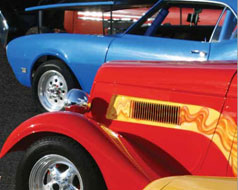The Debate Over Reduced ZDDP and Wear Protection
Do modern motor oils formulated with reduced zinc and phosphorus anti-wear additives provide adequate engine protection? It’s a question some industry insiders, auto enthusiasts and motorists have been asking for years. And as engine builders and classic-car owners continue to experience engine failures they attribute to reduced zinc and phosphorus motor oils, the debate seems to intensify. Lubes ‘n Greases published a feature story on the topic, and it continues to be a hot-button issue on Internet forums and in trade magazines. Arriving at an answer, however, first requires some background information.
What is ZDDP?
Zinc dialkyldithiophosphate (ZDDP) is the most commonly used anti-wear additive in motor oils. It contains both zinc and phosphorus components that work together to provide anti-wear protection and minimize lubricant breakdown. ZDDP also exhibits mild extreme-pressure protection. Some motorists think that increased zinc content equals increased wear protection. Although somewhat true, the statement can be misleading. First, the mere presence of zinc doesn’t mean it is in the form of ZDDP. In other forms, zinc offers additional oxidation protection but little wear protection. Second, other factors influence the oil’s ability to control wear, such as its viscometrics and base stocks. While zinc is important in protecting against wear, the greatest concern should be in using a well-balanced oil that is designed for its intended application.
How ZDDP Works
As temperatures rise and surfaces come closer together, ZDDP decomposes, and the resulting chemistry protects critical metal surfaces. When parts move during operation, any sliding or rolling motion takes place on top of or within the ZDDP anti-wear film, which reduces metal-to-metal contact. This is especially important in modified engines with flat-tappet camshafts because the engine is creating more horsepower than it was designed for, which puts more stress on the engine. High-tension valve springs, often used in racing applications, also increase the potential for cam wear and require additional ZDDP.
Negative Effects of ZDDP

When the American Petroleum Institute (API) and the International Lubricants Standardization and Approval Committee (ILSAC) established phosphorus limits at 0.10 percent weight in 1996, motorists and enthusiasts wondered if it would negatively affect wear protection. The move to reduce phosphorus may not have taken into consideration high-performance and modified engines or engines that had yet to be broken in. The debate intensified in 2004 when the API and ILSAC further limited phosphorus to 0.08 percent, where it remains today.
Despite the reduction, there is no evidence to suggest modern engines using today’s lower-ZDDP oils are suffering widespread wear. A properly formulated oil that meets API SN and ILSAC GF-5 is capable of delivering reliable wear protection in stock engines. In fact, testing shows that AMSOIL Signature Series 5W-30 Synthetic Motor Oil (ASL) offers outstanding wear protection in the Four-Ball Wear Test (ASTM D4172 Mod.).
When it comes to older engines – particularly those equipped with flat-tappet cams – and engines modified for increased performance, the challenges to delivering adequate wear protection become more pronounced.
Flat-Tappet Cams
The design of flat-tappet cams makes them especially vulnerable to wear. As the name indicates, the tappet – or lifter – is flat. During operation the surface of the cam lobe slides rapidly over the surface of the tappet, producing high friction and temperatures. The camshaft and lifters are responsible for triggering the precisely tuned movements of the valvetrain
Without the protective film barrier provided by ZDDP, the cams and lifters wear from the force of operation, negatively affecting cam and valve operation. Because most V-8 engines of the muscle car era came standard with flat-tappet cams, the problem is especially prevalent to classic-car and hot-rod owners.
In these applications, modern oils, such as AMSOIL synthetic motor oils, are capable of providing adequate wear protection after the engine has been broken in. But due to variables like severity of service and level of modification, AMSOIL primarily recommends high-ZDDP oils in these applications, such as Z-ROD® Synthetic Motor Oil (ZRF, ZRT) or DOMINATOR® Synthetic Racing Oil (RD20, RD30, RD50, RD60). When breaking in a rebuilt or high-performance engine, AMSOIL recommends AMSOIL Break-In Oil (BRK), which contains high levels of ZDDP for added wear protection.
Demand for High-ZDDP Oils
Everyone spends a good deal of time searching for oils with zinc. As the debate over ZDDP levels and engine wear continues, many enthusiasts and engine builders will continue to seek out high-ZDDP specialty oils.
AMSOIL ZROD Synthetic Motor Oil (ZRT, ZRF)
is the primary recommendation for older and modified engine designs, such as those with flat-tappet camshafts. It is also designed specifically to resist rust and corrosion that attacks engines during periods of inactivity and storage. (By the time you see this article there will be a new 10W-40 version! )
AMSOIL Premium Protection Synthetic Motor Oil (AMO, ARO)
is the secondary recommendation for older and modified engines that require the protection of added ZDDP.
AMSOIL Break-In Oil (BRK)
is designed to work quickly in new and rebuilt high-performance and racing engines. This SAE 30 viscosity-grade oil features a no friction-modifier formula that helps induce controlled wear in rings to help mate and seat piston rings. It also has very high levels of ZDDP.
AMSOIL DOMINATOR® Synthetic Racing Oil (RD20, RD30, RD50, RD60)
is formulated similarly, but more for true racing applications. It can be used in muscle cars, street rods and other high-performance vehicles with flat-tappet camshafts.







